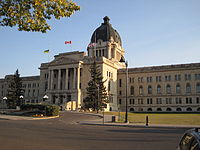Heritage Property Act (Saskatchewan)
| Heritage Property Act | |
|---|---|

The Saskatchewan Legislative Building and its grounds were designated a Provincial Heritage Property in 1978
|
|
| An Act to provide for the Preservation, Interpretation and Development of Certain Aspects of Heritage Property in Saskatchewan, to provide for the continuance of the Saskatchewan Heritage Foundation and to provide for the naming of Geographic Features | |
| Citation | SS 1979-80, c H-2.2 |
| Territorial extent | Saskatchewan |
| Enacted by | Legislative Assembly of Saskatchewan |
| Date enacted | November 28, 1980 |
The Heritage Property Act is a provincial statute which allows for the preservation of cultural heritage properties, archaeological sites and palaeontological sites in the province of Saskatchewan, Canada.
The Act offers two types of protection:
Provincial Heritage Properties are provincially significant places designated by the Minister of Tourism, Parks, Culture and Sport. As of March 2013, there are 50 such sites in Saskatchewan. Once designated, the property's heritage character-defining elements cannot be altered without the written consent from the Minister, and the site is also eligible for financial assistance from the Saskatchewan Heritage Foundation towards its preservation or restoration.
Locally or regionally significant places can be designated by a city, town, village or rural municipality. Designation legally protects the property and makes it eligible for financial assistance from the Saskatchewan Heritage Foundation. There are over 750 Municipal Heritage Properties in the province.
The Act also permits municipalities to designate Municipal Heritage Conservation Districts, larger areas whose heritage value lies in their overall area character rather than in individual properties.
The Act protects archaeological and palaeontological sites and objects in Saskatchewan. In particular, every archaeological or palaeontological object found in, or taken from, land in Saskatchewan is deemed to be the property of the Crown, and no person may disturb or dislocate such objects without a valid permit issued under the Act.
Also protected are Sites of Special Interest, consisting of First Nations or Métis sites which the Act defines as properties containing any pictographs, petroglyphs, human skeletal material, burial objects, burial places or mounds, boulder effigies or medicine wheels. No one may destroy, deface, excavate or alter such sites.
...
Wikipedia
